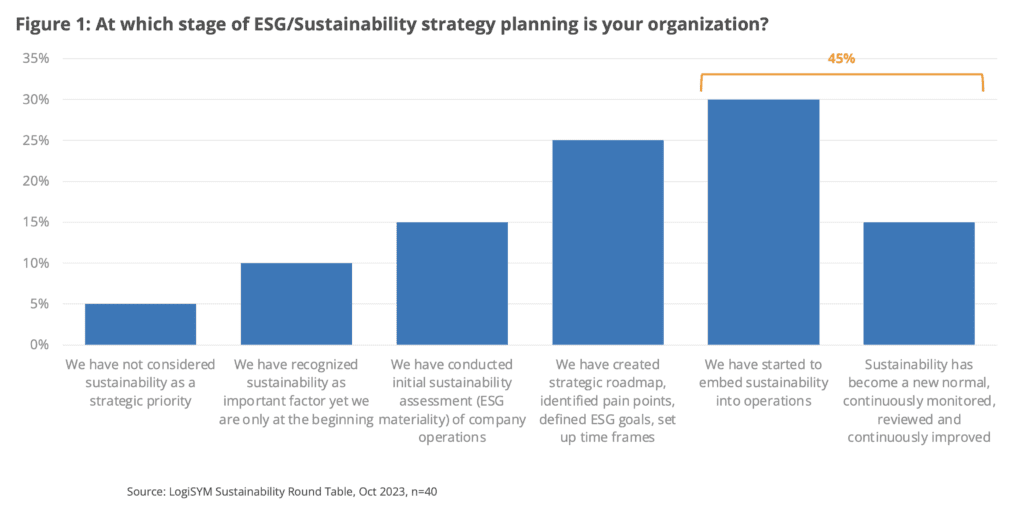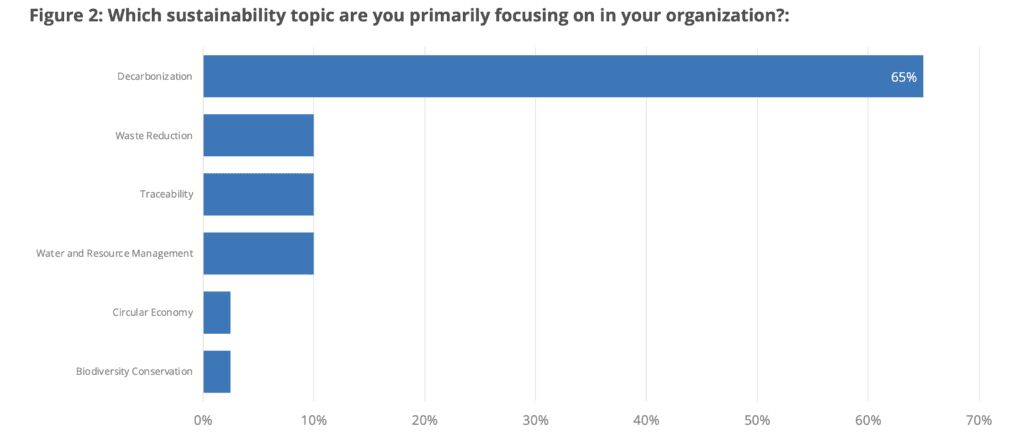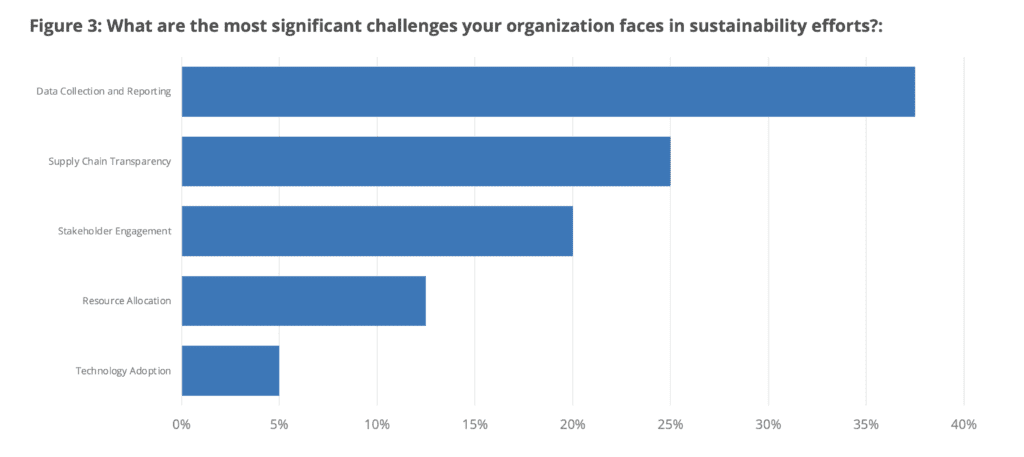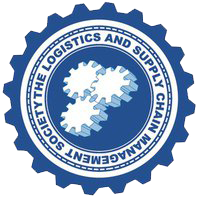
Charting the Course to Sustainable Transportation: Our Journey to a Greener Future
Introduction
At LogiSYM Platinum in October, 2023, the LSCMS Shippers Council recently hosted a round table event, bringing together key players in the logistics and supply chain management sectors to discuss the pivotal theme of sustainable transportation. The event, entitled “Charting the Course to Sustainable Transportation: Our Journey to a Greener Future,” provided a platform for an in-depth dialogue on driving sustainability within the industry, with a particular emphasis on logistics and transportation.
Presentation Highlights
Marcus LeMaster from Schneider Electric initiated the session, introducing the sustainability sub-committee of the Shippers Council. The sustainability sub-committee’s objective is to educate stakeholders on sustainability from a supply chain and logistics perspective. LeMaster highlighted the variety of subcommittees within the council, including those focusing on digitalisation, ocean procurement, and air freight procurement, all working collaboratively to share best practices and spearhead change.
LeMaster underscored the importance of sustainability as a key pillar of the sub-committee’s current agenda, which will expand to include other components of ESG. The sub-committee was running the current round table to drive an inclusive dialogue that spans across consultants, service providers, and the wider shipper’s community. The sub-committee’s priorities for the year were delineated into three focus areas: Climate, Resources, and Social Sustainability, encompassing everything from emissions and biodiversity to addressing issues like slave labour and equality.
Key Discussions and Projects
- A significant portion of the discussion revolved around the initial steps organizations can take towards climate action. To address this, the sub-committee is in the process of developing an infographic and a comprehensive playbook. The playbook will focus on identifying and managing material issues in an organisation, including sustainability efforts such as workforce health and safety, diversity, equity, inclusion initiatives, and emissions reduction. It will emphasize the need to seek support during the sustainability journey and will provide guidance on obtaining assistance. The playbook will feature successful case studies, foundational principles utilizing UN definitions, and the pivotal role of partner organizations in maintaining and verifying standards. It will acknowledge the availability of numerous organizations that will provide structures and consultation services to facilitate the adoption of science-based targets. The playbook will also underscore the value of partnerships in streamlining the process and enhancing efficiency.
- The infographic and playbook document outlines were presented, with the sub-committee inviting comment. The outline presented was as follows:
-
- WHAT> Definition of Sustainability
- WHY> Why Sustainability Matters
- HOW> How We Approach Sustainability
- WHO> The Importance of Partner Organizations
- HELP> Challenges and Headwinds
- REPORT> The Need for Data & Role of Technology
- FUTURE> Future Sustainability Initiatives
- SHOW ME> Examples of How to Take Next Steps
As part of the playbook discussion, the vital role of partnerships and the need for external support was highlighted, including the need for certification bodies and agencies. Brett Marshall, Head of Quality from Zuellig Pharma noted the complexity of the certification process and the extensive data collection and people involvement required to validate sustainability efforts and reduce duplication of reporting.
- Glossary: During the meeting, Michael Lecomte, Senior Logistics Director APAC at COTY, explained the significance of the glossary that the company has been working on. He emphasised that it plays a crucial role in simplifying sustainability terminologies and acronyms. He also highlighted that the glossary serves as a valuable tool to bridge the gap between corporate communication on sustainability and employee understanding. The glossary aims to ensure that logistics professionals comprehend the language used in sustainability.
Audience Engagement
The event also incorporated interactive segments, with the audience being polled on their organizational backgrounds, their current stage in ESG sustainability strategy planning, and their primary focus within the realm of sustainability. These interactions provided valuable insights into the audience’s perspectives, showcasing a diverse range of focuses and challenges within the sustainability journey.
In a poll of 40 audience members, it was revealed that 45% of them belong to organisations that have initiated sustainability projects as part of their operations (refer Figure 1).

This means that the remaining 55% of organizations still need to start to integrate sustainability into their supply chain processes. This can have several implications for the industry:
1. Companies that do not focus on sustainability measures might miss opportunities to reduce costs and improve efficiency, as sustainability practices often lead to better resource utilization and waste reduction.
2. These organizations may face increasing pressure from customers, investors, and regulatory bodies to adopt sustainability practices. This could negatively impact their market competitiveness and access.
3. Companies that do not embrace sustainability risk damaging their reputation, especially in an era where corporate social responsibility is paramount.
4. Companies that do not adopt sustainable practices could face supply chain disruptions due to climate events or resource scarcity, disproportionately affecting their resilience.
Overall, the industry may witness a growing divide between sustainability leaders and laggards, with the latter facing risks to their long-term viability and relevance.

Decarbonisation was identified as a critical area of focus for those in the room, significantly ahead of other areas of focus, such as waste reduction, traceability, and water and resource management (refer Figure 2). Brand owners in Singapore may prioritise decarbonisation due to several compelling reasons. Firstly, Singapore has set ambitious carbon reduction targets and regulations, prompting companies to align with government initiatives for compliance and reputation management. Second, as a trade-dependent nation, brand owners in Singapore recognise that decarbonisation can enhance their global competitiveness and access to markets that increasingly demand sustainable products and practices. Moreover, Singapore’s limited land and resources make energy efficiency and decarbonisation critical for sustainability. Finally, the heightened awareness of climate change and its impact on supply chains and consumer preferences underscores the urgency of addressing decarbonisation as a priority sustainability topic for brand owners in the region.

Reflecting the skew of organizations towards goal setting, data collection and roadmap development in terms of their sustainability journey maturity, it was no surprise that the top challenges for many organizations are:
1. Data collection and reporting, which can be difficult due to the lack of a standardised sustainability reporting framework. Additionally, different countries may impose varying regulations and guidelines, adding complexity for organisations operating across borders.
2. Achieving supply chain transparency, which can be challenging due to the global supply chain complexities that involve multiple tiers of suppliers in various regions. Ensuring visibility throughout the supply chain can be resource-intensive and technologically challenging.
3. Stakeholder engagement, which can be a challenge as organisations may need help to identify key stakeholders and effectively communicate their sustainability efforts. The cultural and linguistic diversity in the region can compound these issues.
Conclusion
In conclusion, the LSCMS Shippers Council round table event provided a productive forum for discussing sustainable transportation in the logistics and supply chain sectors. The presentations, discussions, and tools introduced, such as the sustainability playbook and glossary, reflect a growing awareness and willingness to address environmental and social challenges within the industry. The event shed light on current sustainability efforts and initiated conversations about future collaborative endeavours.
The participation and insights shared by attendees suggest a continued focus on sustainability, highlighting the importance of ongoing dialogue and practical steps in advancing these initiatives. However, there is a risk that the complexity of new regulations in sustainability are causing fatigue, resulting in organisations being less prepared than they need to be. As the industry moves forward, the discussion at this event suggests that while a steady, collaborative approach to addressing these complex issues is possible, we still have a fair ways to go in understanding requirements and being able to operationalise sustainability practices.
